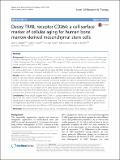| dc.contributor.author | Madsen, Sean D. | en_US |
| dc.contributor.author | Russell, Katie C. | en_US |
| dc.contributor.author | Tucker, H. Alan | en_US |
| dc.contributor.author | Glowacki, Julie | en_US |
| dc.contributor.author | Bunnell, Bruce A. | en_US |
| dc.contributor.author | O’Connor, Kim C. | en_US |
| dc.date.accessioned | 2017-12-06T05:49:56Z | |
| dc.date.issued | 2017 | en_US |
| dc.identifier.citation | Madsen, Sean D., Katie C. Russell, H. Alan Tucker, Julie Glowacki, Bruce A. Bunnell, and Kim C. O’Connor. 2017. “Decoy TRAIL receptor CD264: a cell surface marker of cellular aging for human bone marrow-derived mesenchymal stem cells.” Stem Cell Research & Therapy 8 (1): 201. doi:10.1186/s13287-017-0649-4. http://dx.doi.org/10.1186/s13287-017-0649-4. | en |
| dc.identifier.issn | | en |
| dc.identifier.uri | http://nrs.harvard.edu/urn-3:HUL.InstRepos:34492150 | |
| dc.description.abstract | Background: Mesenchymal stem cells (MSCs) are a mixture of progenitors that are heterogeneous in their regenerative potential. Development of MSC therapies with consistent efficacy is hindered by the absence of an immunophenotype of MSC heterogeneity. This study evaluates decoy TRAIL receptor CD264 as potentially the first surface marker to detect cellular aging in heterogeneous MSC cultures. Methods: CD264 surface expression, regenerative potential, and metrics of cellular aging were assessed in vitro for marrow MSCs from 12 donors ages 20–60 years old. Male and female donors were age matched. Expression of CD264 was compared with that of p16, p21, and p53 during serial passage of MSCs. Results: When CD264+ cell content was 20% to 35%, MSC cultures from young (ages 20–40 years) and older (ages 45–60 years) donors proliferated rapidly and differentiated extensively. Older donor MSCs containing < 35% CD264+ cells had a small size and negligible senescence despite the donor’s advanced chronological age. Above the 35% threshold, CD264 expression inversely correlated with proliferation and differentiation potential. When CD264+ cell content was 75%, MSCs were enlarged and mostly senescent with severely compromised regenerative potential. There was no correlation of the older donors’ chronological age to either CD264+ cell content or the regenerative potential of the donor MSCs. CD264 was upregulated after p53 and had a similar expression profile to that of p21 during serial passage of MSCs. No sex-linked differences were detected in this study. Conclusions: These results suggest that CD264 is a surface marker of cellular age for MSCs, not the chronological age of the MSC donor. CD264 is first upregulated in MSCs at an intermediate stage of cellular aging and remains upregulated as aging progresses towards senescence. The strong inverse correlation of CD264+ cell content to the regenerative potential of MSCs has possible application to assess the therapeutic potential of patient MSCs, standardize the composition and efficacy of MSC therapies, and facilitate aging research on MSCs. Electronic supplementary material The online version of this article (doi:10.1186/s13287-017-0649-4) contains supplementary material, which is available to authorized users. | en |
| dc.language.iso | en_US | en |
| dc.publisher | BioMed Central | en |
| dc.relation.isversionof | doi:10.1186/s13287-017-0649-4 | en |
| dc.relation.hasversion | http://www.ncbi.nlm.nih.gov/pmc/articles/PMC5622446/pdf/ | en |
| dash.license | LAA | en_US |
| dc.subject | Mesenchymal stem cells | en |
| dc.subject | Cellular aging | en |
| dc.subject | Heterogeneity | en |
| dc.subject | Decoy TRAIL receptor | en |
| dc.subject | CD264 | en |
| dc.title | Decoy TRAIL receptor CD264: a cell surface marker of cellular aging for human bone marrow-derived mesenchymal stem cells | en |
| dc.type | Journal Article | en_US |
| dc.description.version | Version of Record | en |
| dc.relation.journal | Stem Cell Research & Therapy | en |
| dash.depositing.author | Glowacki, Julie | en_US |
| dc.date.available | 2017-12-06T05:49:56Z | |
| dc.identifier.doi | 10.1186/s13287-017-0649-4 | * |
| dash.contributor.affiliated | Glowacki, Julianne | |


